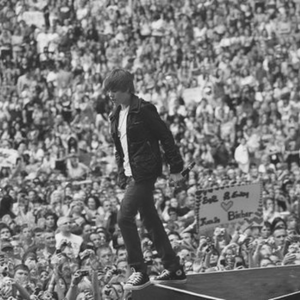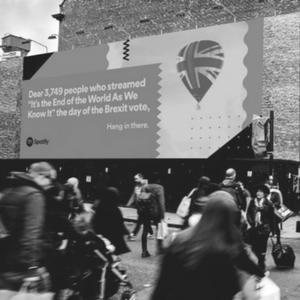


Will a Spotify advertising campaign send your sales in One Direction?




Spotify advertising is a fascinating topic, and we explain how you can use this brilliant medium even more brilliantly than you ever could have dreamed. Three words - targeting, targeting, targeting.
So, just to re-cap, Spotify is a digital music service which gives users access to millions of songs instantly. Increasing numbers of people are using this channel to stream music every day, and many brands are seeing some pretty impressive Spotify advertising statistics as a result.
Advertising on Spotify
People are making more and more time to consume audio content. On average, half of internet users worldwide are now streaming. In more mature online markets like the US and Sweden, over 60% of the population streams.
This trend will only keep growing, since many streamers are Gen Z digital natives. They have grown up streaming, and are now listening across multiple devices at work, rest and play. And the more they listen, the more opportunities there are to connect with them.

One big bonus associated with running a Spotify advertising campaign is that people don’t mind the ads. In fact, 75% of digital audio listeners say commercials are a fair price to pay for free audio content.
Listeners also prefer the digital environment. Of survey respondents who listen to both traditional AM/FM radio and digital audio, 69% acknowledge that traditional radio has more commercials, and 47% find ads less intrusive when listening online than on traditional radio.
So, this all seems positive, and with all this engagement across the channel there comes a massive opportunity for advertisers. But here’s the question: How can I target my ideal audience?
Whilst advertising on Spotify hasn’t quite caught up with Facebook’s data targeting, the platform does have some cool options which can help you find your customers.

Genre and content targeting
You can use genre and content targeting to ensure your Spotify advertising campaign reaches users with habits, beliefs and tastes which align with your carefully created personas.
For example, if you are a sports brand, you can target people who consistently listen to workout playlists. If you’re selling homeware, then you can target people who listen to dinner party playlists.
There are currently eight content themes you can advertise across (workout, focus, commute, relax, party, travel, dining and romance). These categories are created using first-party data which identifies user-generated and Spotify-curated playlists aligned with popular activities and moods.
Spotify creates audience segments by identifying users that listen frequently to playlists in each category. This data is refreshed daily based on new playlists, new users, and overall streaming activity. In short, fresh and responsive data sets are created for you every day!
Spotify advertising demographics
One of the best things about Spotify advertising is that all the data is first party generated and freshly based on user interaction. It also pulls in multiple third party data sources to give a highly layered approach. Spotify is therefore excellent for powerful data analysis, mixing in-the-moment data with a strong third party solution, making it great for a variety of campaigns.

Below, we’ve outlined all the ways in which you can target people on Spotify:
-
Geography, language, age and gender
Advertising on Spotify can be targeted according to a user’s language, age and gender, specified by the user registration data. You can also target users’ geographical location at a country or city level across more than 50 countries around the world, based on the Internet Protocol (IP) address of their current Spotify session.
-
Behavioural segments
Spotify advertising can also reach in-market purchase intenders and category enthusiasts across a variety of brand verticals. Spotify has crafted a suite of behavioural segments by analysing users’ streaming habits, alongside their broader interests, lifestyle, and shopping behaviours. All this is fuelled by leading third-party data providers in a similar way to Facebook and Twitter.
-
When they're listening
So now we know how you can target Spotify users, we can look at when you can target them to ensure your message is delivered at the right time.
People listen to music from morning to night, not just during traditional peak hours. You can alter your advertising on Spotify according to different times of the day. For instance, if you were selling relaxing toiletries or face masks, you might send your messages during peak work times or rush hour, aiming to build anticipation around using your product later that evening.
-
How they’re listening
We all know how important mobile and tablet are these days, you simply can’t ignore them. Luckily, Spotify advertising campaigns can be served to users dynamically, based on their active platform. Spotify app platforms include iPhone, iPad, Android (all devices), desktop, web player and even PlayStation.
Spotify also allows for mobile operating system including iOS, Android, Windows Phone and more than 200 mobile service providers across the globe.
-
Retargeting and sequential messaging
As with all platforms, you can use retargeting to hit cross-platform users based on previous engagement or exposure across all Spotify app platforms. I can’t stress how much I love retargeting, it’s vital for success. By introducing retargeting, Spotify advertising adds another string to your bow in terms of engaging with consumers.
Further to this, sequential messaging allows you to deliver longer-form brand and product narratives. This is currently available for audio and standard display. It allows you to create content that engages your consumers in a way which not only builds your authority, but also your brand fan base.

So, there you have it. You now know the formats you can use to create ads, and the ways in which you can find your perfect consumers. Now what you should do is create some mint content to go with your Spotify advertising campaign…. kind of like Spotify did themselves!








